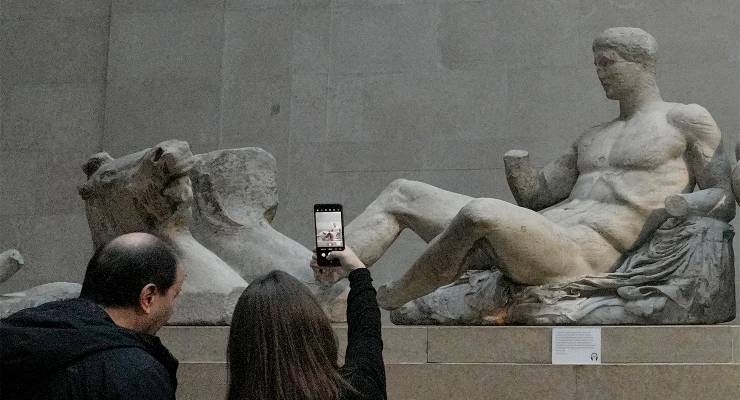
The Parthenon Marbles, widely believed to be one of the “most important collections of classical art in existence”, were stolen from the Acropolis of Athens in Greece, at the dawn of the 19th century, by an Englishman entrusted to serve as an ambassador.
Recently, UK Prime Minister Rishi Sunak cancelled a slated meeting with Greek Prime Minister Kyriakos Mitsotakis a day after Mitsotakis had told the BBC that the marbles should be returned. Sunak’s clumsy decision has thrown the issue of the marbles back into global headlines, especially at a time when colonialist behaviour and cultural theft are increasingly newsworthy.
For 2,500 years, through times of war and peace, the magnificent sculptural artworks that form the Parthenon graced Athens as a place of national focus honouring ancient gods and civic virtues. Then, between 1801 and 1805, the UK’s ambassador to the Ottoman Empire, Thomas Bruce, the 7th Earl of Elgin, ordered the removal of core elements of the Parthenon’s frieze for “safekeeping” overseas, with the permission of local authorities.
So what exactly did that look like?
“Removal” involved Elgin’s men climbing ladders and irreparably damaging the Parthenon with saws — by workers who’d been engaged at Elgin’s expense (his government had refused), initially only to research and document — leaving in Athens only “30% of the original remaining sculptures” while taking the rest to Britain.
The “authorities” weren’t local. Elgin claimed to have secured written permission from the Ottomans, the occupying force that the Greeks would overthrow in the Revolutionary War a mere two decades later. No copy of any such authority document exists in Turkey, and the status of a letter in the British Museum’s collection remains disputed.
“Safekeeping” meant private storage at various locations, including Elgin’s home — some were lost in a shipwreck, only to be recovered at great personal expense over three painstaking years. (Again, he was unable to secure government or private backers; in one plea for funds, he described the lost sculptures as “stones of no value”.) At a great financial loss to Elgin, covering less than half of his expenses, Greece’s national treasures were then only sold to the British Museum, when the former ambassador was approaching bankruptcy over a decade later after the end of his marriage to the heiress who’d funded his exploits.
It’s a sordid tale in anyone’s book. Lord Byron, who died defending Greece in the 1821 Revolutionary War, famously called Elgin’s actions vandalism.
What’s changed this time is that the chair of the British Museum, George Osborne, has been willing to call Rishi Sunak out politically as well as ethically. Despite being constrained by a 1963 law that prevents the return of any ancient object in its collection — and a point of contention remaining regarding the Greek government’s refusal to acknowledge the British Museum’s ownership of the sculptures — the British Museum has been actively exploring long-term loan and cultural exchange options.
“That is, I think, something worth exploring,” said Osborne, “and we can go on doing it whether or not Rishi Sunak meets the Greek prime minister. In fact, if anything, things have been rather clarified by this week. We obviously know we’re not going to get any particular support from the Conservative government.”
Even King Charles chose to shirtfront Sunak publicly at their very next encounter, choosing the year’s most critical global forum to greet his prime minister at COP28 wearing a tie boldly featuring the Greek flag, ready with a smile for all the world’s media to photograph.
In the more recent years in Greece’s two-century-long progress towards securing the return of their property, the nation has built a bespoke museum to ensure its safe, culturally appropriate exhibition in an ongoing research environment.
The award-winning architecture of Bernard Tschumi and Michael Photiadis Associates’ Acropolis Museum rests elegantly atop a working archaeological dig, while inside, visitors can see conservation and restoration work carried out right before their eyes. Transparency is built into the museum’s design, with see-through floors and abundant natural light.
While the Acropolis is part of everyday life for Greeks, 64% of Britons have never visited the British Museum, its trustees are “the world’s largest receivers of stolen property” according to Geoffrey Robertson QC, and earlier this year it was revealed that one of the museum’s staff had stolen some 2,000 objects from its collection, including Greek treasures, across several years.
Also embedded in the Acropolis Museum’s design are values of fidelity and integrity. In a bold move clearly expressed in its architecture, the museum’s top floor shifts in orientation to face the Parthenon, and its dimensions match it precisely. This space has been designed to exhibit the sculptures as the one coherent artwork that visitors to the Acropolis were always meant to experience. All that’s missing are the stolen artworks.
The return of the Parthenon Marbles is inevitable, whether permanently or under a long-term loan arrangement. Meanwhile, Sunak has a lot of hard work to do to rebuild trust with Europe as well as with the UK’s substantial Greek diaspora community. Archbishop Elpidophoros, leader of the Greek Orthodox Archdiocese of America, said that Sunak’s disrespect “deeply insults Greeks worldwide”. He’s right, but the reality of the offence is more complex.
At the heart of this matter are vain attempts by the post-Brexit UK to cling on to European cultural authority, by maintaining an outdated colonial stance increasingly recognised as fraudulent. While museum practice worldwide has long since evolved to take an explicit stance against the myth of cultural neutrality, UK politics lags well behind.
Sawtooth diplomacy helps no-one; sledgehammer methods end only in destruction. It’s time for the UK to own its cultural history and lead the way in building meaningful, respectful relationships.








Describing 600 years of Ottoman rule as an “occupation” is a spicy take – demanding the return of Constantinople next?
The Guardian (that well known Imperialist rag) claims that there is general agreement that the marbles would have been more damaged had they remained in Athens and hence were saved by being brought to London, that the Parthenon was a ruin back in the day (and has been reconstructed since) and that the Sultan did issue a firman which is preserved. All minor points not covered in this article
https://www.theguardian.com/education/2004/jul/21/highereducation.parthenon